This post may contain affiliate links. Please see our disclosure policy.
Historical canning books were very different from those used today, and the practices, terminology, and even the definition of the word “canning” was different a hundred years ago.
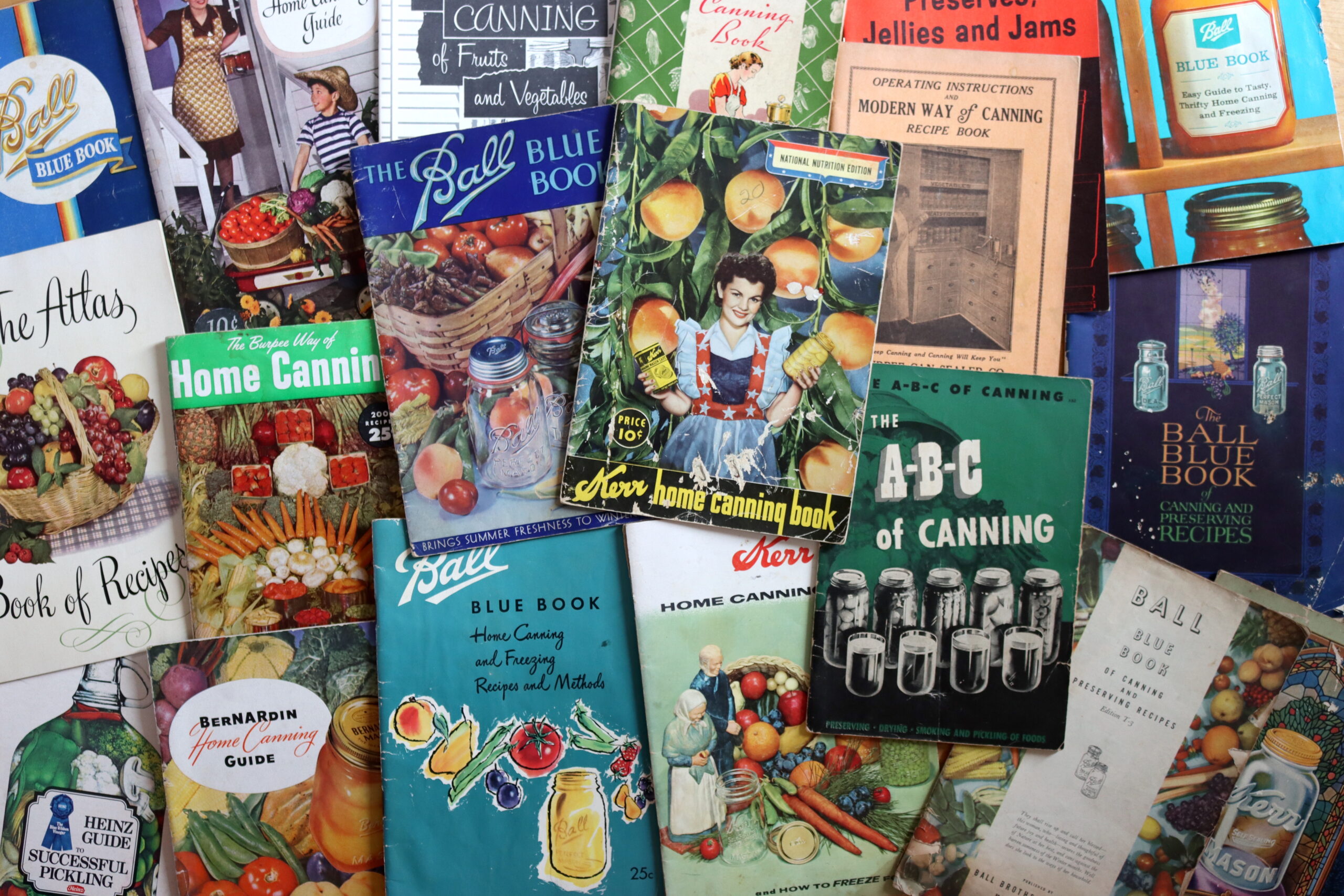
Table of Contents
(These books and resources are listed for historical reference only. The National Center for Home Preservation does not recommend canning using any canning guide older than 1994, as these guides contain outdated practices and are not up to modern food safety standards. I do not use or endorse these canning methods.)
I love paging through old cookbooks, and as an avid canner, I love old canning books just as much. Home canning was very different in the early 1900s, and not only was the terminology different, but the actual canning practices were very different as well.
Some people talk about how their grandmother and great-grandmother used to put up green beans by water bath canning them for 3+ hours. Those practices all existed, but when you read about them in the actual source material, you learn subtleties that haven’t made it through the generations. Though these practices are not endorsed by the USDA today, they did, in fact, work, and still do, with some pretty big caveats. The resulting products are not what we think of when we think of “canned goods” on the supermarket shelf.
To be clear, I do not endorse any of these canning methods, and there’s a reason they’re no longer considered safe. But there’s also a reason why your great-grandmother used them and still lived to a ripe old age. As they say, Russian Roulette is perfectly safe 5 out of 6 times, but that doesn’t mean you should play.
(Though, believe it or not, many of the recipes are exactly the same as you’ll find in modern sources. Some things change, and some things stay the same. That’s just the way of things.)
I’m posting these for historical reference, as in many cases, people don’t properly understand how canning was done historically. The process of canning, and the simple definition of what “canned food” meant was different in the early 1900s. I think it’s fun to realize how much things have changed, and as a prolific home canner, I love reading about canning history. That doesn’t mean you should use these as a guide to canning in your modern kitchen.
Over the years, I’ve picked up dozens of vintage canning books from garage sales, eBay, and Etsy. I collect them as a link to the past, in the same way that I collect old canning jars for display. Many of these books are available in PDF form for free online, and those links are below for anyone wishing to page through a bit of canning history.
You will find links to more than 100 historical canning books at the end of this article. But first, I think it’s important to understand some of the terminology and practices you’ll find there.
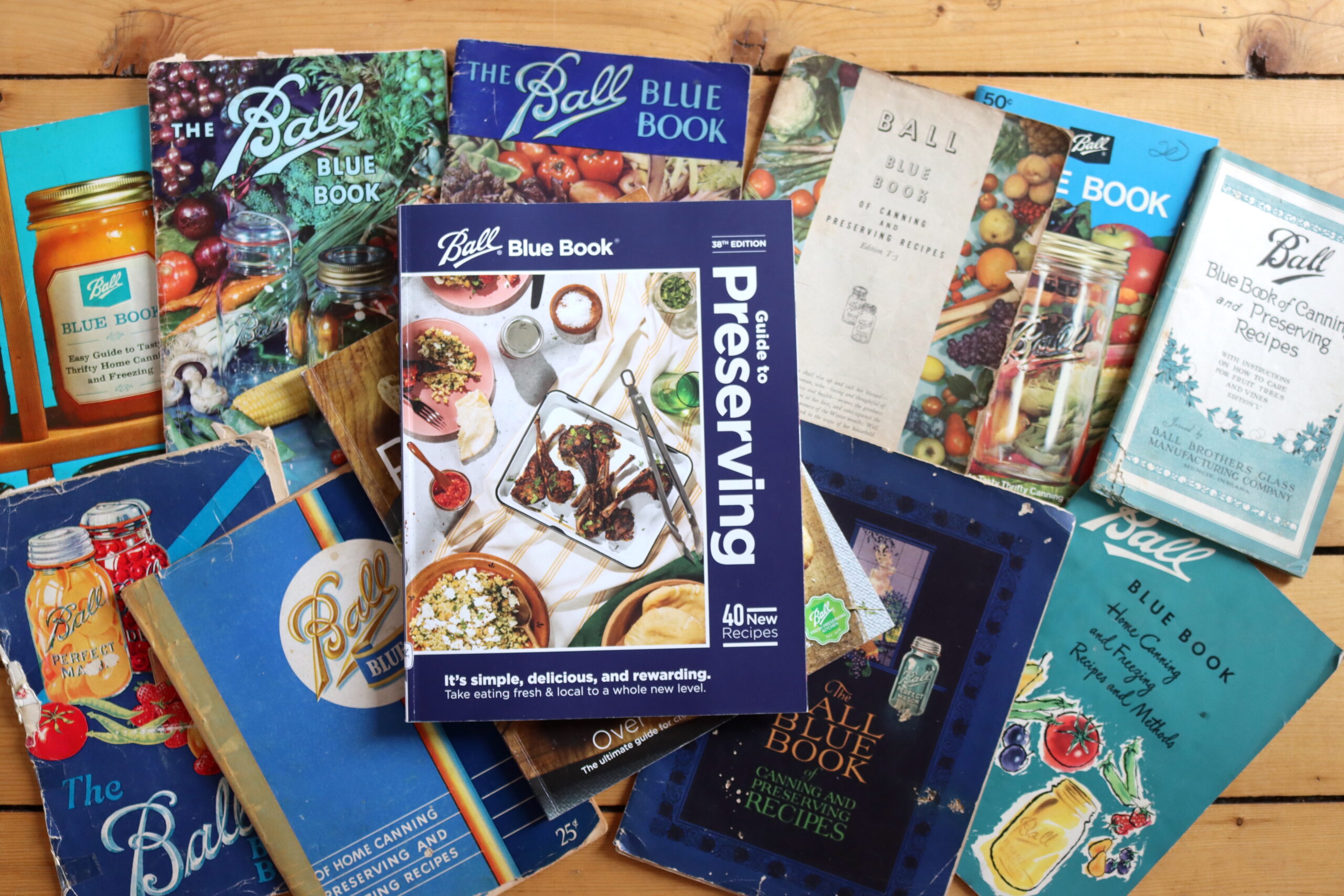
Historical Vrs. Modern Canning
These days, high-acid jams, jellies, and pickles are water bath canned at 212 degrees F to sterilize them (as botulism can’t survive in an acidic environment). Low-acid foods like meat and vegetables must be canned in a pressure canner at much higher temperatures, above 240 degrees F. This sterilizes the contents of the jars, and in the modern era, we expect that canning equals sterilization…and that you can just eat the contents with a fork right out of the jar.
That wasn’t always the case, and historically, canned food did not mean that the contents of the jar were safe to eat as is.
Even in the 1920s, the canning books talked about the difference between “processing” and “sterilization,” and they were aware that water bath canning low-acid vegetables and meats didn’t actually sterilize the contents. That old-time practice only “processed” them so that the canned goods would be kept in a cold cellar for a while.
According to a USDA publication from 1923, “The spores of some bacteria have been found to resist the temperature of boiling water for 38 hours. Of course, no one would think of cooking young, tender vegetables for that length of time.” Of course, that same publication recommended processing jars for 1 to 3 hours, depending on the contents, but it acknowledged that the processing time just allowed the jar to keep without molding, bubbling, or visibly spoiling on the cold cellar shelf. Everyone knew that botulism can still survive that process, even when these canning books were written.
Botulism is deadly, but doesn’t impact the flavor of food, so further precautions were taken at serving to de-toxify the jar’s contents at serving.
Upon serving, home canners in the early 1900s knew that if they did water bath can low acid vegetables and meats; they couldn’t serve them raw. The jars had to be boiled on the stovetop for at least 15 minutes, specifically to denature any botulism toxin that may have developed in the jar. Botulism is rare, but still, they knew not to take the chance. Jars we kept cool in a cellar, and always re-cooked at serving.
Every old canning book from the 30s and 40s talks about how vegetables and meats must be re-boiled at serving, with no exceptions. Though those books have side-by-side recommendations for pressure canning meat for under an hour and water bath canning meat for 3+ hours, they treated the end result the same. All of it still must be boiled before serving, and you couldn’t even try a bite or lick your fingers after opening the jar, because it hadn’t been re-boiled.
Can you imagine those kinds of warning labels on a jar of beans at the supermarket today? “Warning: Do not eat raw; it is deadly toxic. Boil for 15 minutes before serving.” We expect different things from preservation these days, but historically, preservation didn’t mean infinite shelf life under any conditions.
These days, canning means a very different thing, and we expect low-acid meats and vegetables to be processed to complete sterilization at high temperatures in a pressure canner (240F or higher). We expect to be able to keep canned goods at room temperature, and we assume that the canning process completely sterilizes the contents. That’s why canning authorities no longer recommend these practices, as the common definition of what’s expected in “canning” has changed over time.
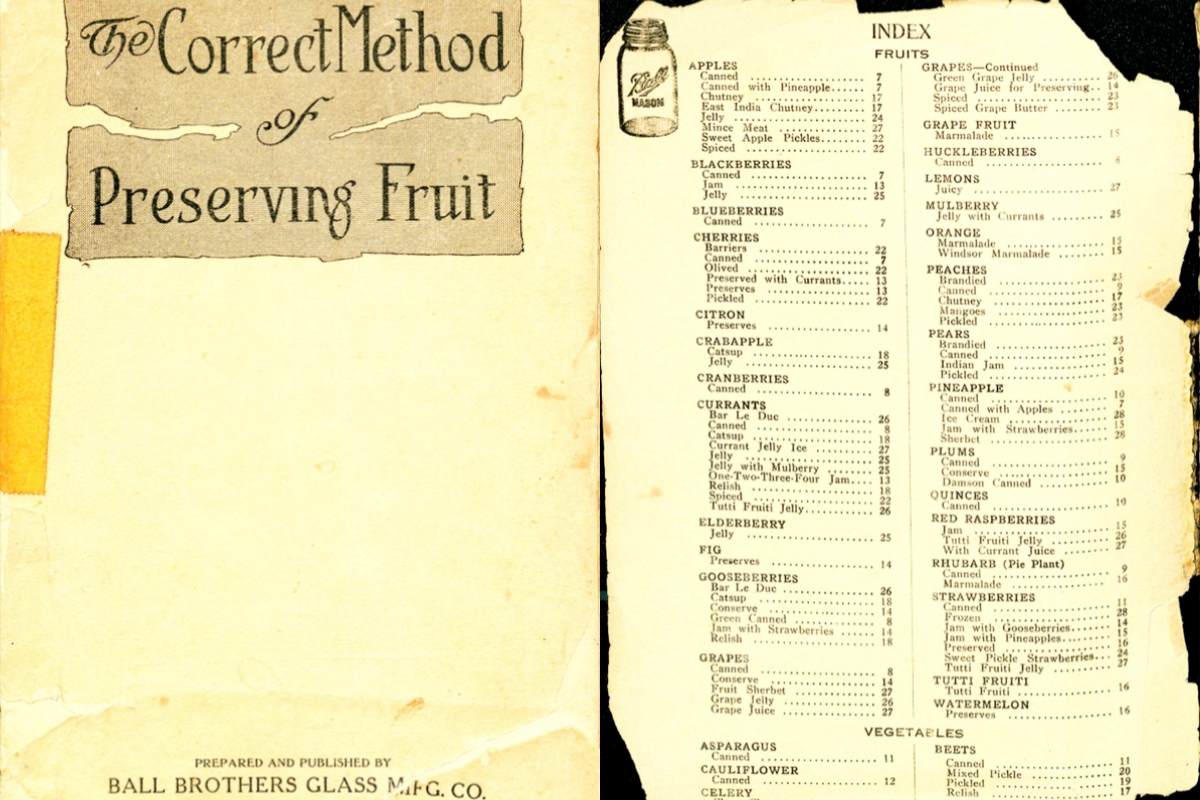
Serial Canning
There are other techniques mentioned, such as serial canning, where jars of meat and vegetables were water bath processed for hours multiple times, repeatedly over the course of several days. The goal of this was actually to cause botulism spores to sprout in the jar by creating anaerobic conditions with the first day’s canning. The jars are then reprocessed the next day to kill off the just-hatched spores. They’re then reprocessed again on the 3rd day to catch any lingering ones.
Again, home canners were aware that water bath canning low acid products killed bacteria, but boiling temperatures, even for 3+ hours, didn’t kill botulism bacteria spores. They’re coming up with ways around that problem, creatively, I might add, but even with serial canning, the contents of the jars are always thoroughly recooked at serving.
Open Kettle Canning
When it comes to high-acid jams, jellies, and pickles, the practices are different as well. These days, those are sterilized by water bath canning because botulism and other toxins cannot live in acidic conditions. Old-time canning practices, such as “open kettle canning” of jams and pickles, are still practiced in many parts of the world today. In Europe, jams and jellies are just ladled from the pot directly into sterilized jars, and then capped. They’re not then processed in a water bath canner.
Those practices existed back in the early 1900s as well, but there’s something European canners still know (that Americans knew back then, too). Open-kettle canned jars of jam are not sterilized and can still spoil. In Europe, they only do this with high-sugar jams, where the sugar content is so high that bacteria are inhibited. Even still, they know the jars must be kept cold, and could mold over time.
Oven Canning
Sometimes used for high-acid preserves, oven canning simply heated jars in the oven instead of a boiling water bath. At the time, it seemed like one heat was just as good as another, and who wants to steam up the kitchen if you can just process jars in the oven?
It turns out dry heat in an oven isn’t nearly as good at transferring heat into the jars, and it takes much longer to get proper processing. You also risk jar breakage from thermal shock, much more so than when water bath canning. For those reasons, this method is no longer used. While a bit more dependable than open kettle canning in terms of food safety, it’s impossible to develop accurate oven canning times as the heat circulates very differently in an oven than it does in a pot of boiling water.
Still, there are specific oven-canning books from the 1910s and 1920s that describe the process and try to sell specialized canning ovens, like this one.
These days, when people describe oven canning, they’re often canning things like flour or cakes…which were not canned historically. Canning these things can actually be really dangerous, and while raw flour will keep in a cool, dry, well sealed place for a long time…canning it can actually cause spoilage and food safety issues. This is one place in particular where old-time canning practices are vastly misunderstood, and this is not something great grandma did!
Historical Canning Terminology
The canning books of the early 1900s also discuss this, knowing even then that spoilage and short shelf life were the consequence of open kettle canning (or hot pack canning, as it was called then). Page after page in these books is devoted to managing spoilage and checking for spoilage in these jars periodically, as they are not sterilized, only “processed.”
Ironically, what we call “Water Bath Canning” or “Hot Water Bath Canning” today was then called “Cold Pack Canning,” meaning that the jars were packed cooler than boiling, and then processed in boiling water to seal them.
So long as you realize that these books are talking about something that is altogether different than what people mean when they say “canned goods” these days, these books can be incredibly educational and fun to read. You can learn about old food preservation practices as they existed from the primary source.
Many people do, in fact, still practice these old-time canning techniques. Given that, I think it’s important that everyone realize that they do, in fact, work, but as great grandma knew, not in the same way that canning works today. If you’re going to practice old-time canning, you should actually understand what you’re doing and what it means for the products you preserve. If you’re going to preserve a centuries-old practice, I think it’s important to preserve it correctly; following these steps that they knew even then is critical to ensure safe food made it to the table.
Even still, there’s a reason that pressure canning is the only recommended method for canning low-acid meats and vegetables today. There are inherent risks in even handling jars that could contain botulism toxin, and it’s just not as safe as properly processing the jars in a modern pressure canner according to current published processing times.
Vintage Canning Books
These are old canning books that are out of copyright. They’re written by individual authors rather than corporations (like Ball Canning) or government agencies.
I’ve listed all the Ball, Kerr, Bernardin, and other canning company books separately. Similarly, the books put out by the US government are listed separately, and there are quite a few, as they were especially prolific during WWI and WWII.
- The Book For All Households: Preserving Animal and Vegetable Substances (1811) – One of the very first canning books ever produced, commissioned by the French Minister of the Interior to help create a guide for preserving foods for long sea voyages. Via the Library of Congress
- The Preservation of Food (1857)
- The Art and Mystery of Curing, Preserving and Potting All Kinds of Meats, Game and Fish; Also the Art of Pickling and The Preservation of Fruits and Vegetables (1864) By A Wholesale Curer of Comestibles
- The art and mystery of curing, preserving, and potting all kinds of meats, game, and fish; also, the art of pickling and the preservation of fruits and vegetables (1864)
- Peterson’s Preserving, Pickling and Canning Fruit Manual (1869)
- Canning and Preserving (1887) by Mrs. S.T. Rorer
- The Secrets of Canning: A Complete Exposition of the Theory and Art of the Canning Industry (1890) By Ernest Schwaab
- Ayers Preserve Book (1893)
- The Art of Canning and Preserving as an Industry (1901) by Jan Packrette
- The Story of Canning and Recipes (1910)
- Canned Foods: Fruits and Vegetables (1913) by Florence Corbett
- Canning, Preserving, and Pickling (1914) by Marion H Niel
- Successful Home Canning (1914) by Muriel Gilbert
- Canning, Preserving and Jelly Making (1915) by Janet M Hill
- The Canning of Fruits and Vegetables (1916) by Justo Zavalla
- Canning and How to Use Canned Foods (1916) by AW and KG Bitting
- Jam Book (1916) by May Byron
- Canning and Preserving (1917) By Mary Wright
- War food; practical and economical methods of keeping vegetables, fruits and meats (1917)
- Successful Canning and Preserving: A Practical Handbook for Schools, Clubs and Home Use (1917) by Ola Powell
- Canned Fruit, Preserves, and Jellies (1917) By Maria Parloa
- Every Woman’s Canning Book: The A B C of Safe Home Canning and Preserving (1918) by Mary B. Hughes
- Home and Farm Food Preservation (1918) William Vere Cruess
- Preserving and Pickling (1919) by Gesine Lemcke
- Home Canning and Drying Of Fruits and Vegetables (1918, National War Garden Commission)
- Cold Pack Canning (1919)
- Every Step in Cold Pack Canning (1920) Grace Gray
- A Little Preserving Book for a Little Girl (1920) Amy Waterman
- Canning, Pickling and Preserving (1920s) By Winthrop College for Women in South Carolina
- Laboratory Manual of Fruits and Vegetable Products (1922) William Vere Cruess and AW Christie
- A Complete Course in Canning (1924)
- Lorain Oven Canning (1928)
- Best Pickle Recipes (1931) From the Readers of Better Homes and Gardens
- Home Canning for Better Family Meals (1932) Emma Sparks
- The A.B.C. of canning : preserving, drying, smoking and pickling of foods (1942) by Ruth Berolzheimer
- Old Time Pickling and Spicing Recipes (1953)
Vintage Cookbooks That Include Canning Recipes
These vintage cookbooks aren’t specifically canning books, but preserving was just a fact of life when they were produced.
They happen to include quite a few canning and preserving recipes, especially for jams, jellies, pickles, and relishes.
- Practical Housekeeping: A Careful Compilation of Tried and Approved Recipes (1883)
- What to Eat and How to Cook It With Rules For Preserving, Canning and Drying Fruits and Vegetables (1874) by John Cowan
Old Ball Blue Book Editions
The Ball Blue Book is one of the most comprehensive resources for home canners, and they’ve recently put out their 100th-anniversary edition and then updated it again with their new 38th edition in 2024. (Here’s where you can see what’s new in the newest 38th edition of the Ball Blue Book, as well as a look back at the history of the Ball Blue Book.) Many of the very first editions are out of copyright, and they’re now hosted on university library websites.
- The Correct Method of Preserving Fruit (1909): This is the first edition of the “Ball Blue Book,” which had a different name until 1916. It was originally just a short pamphlet put out by the jar manufacturer and later grew into a whole book with over 100 printings. I requested a copy of this book from the University of Iowa, and they were kind enough to scan it for me.
- Ball Blue Book Edition M (Circa 1920/1921): This copy doesn’t have an actual date printed, but it still uses the name “Ball Brother’s Glass Manufacturing Company,” which was changed to the “Ball Brother’s Company” in 1922. The previous “Edition L” was put out right after the end of WWI, in either 1919 or 1920, so this edition is roughly dated to 1920 or 1921.
- How to Use the Foods You Can (1924, Ball Brother’s Company): Not specifically a canning book, but a companion to the Ball Blue Book that takes home canned food and turns it into meals and baked goods. The recipes come directly out of the Blue Book Edition M (above), and incorporate pint and quart jars of fruit, meat and more into meal recipes.
- Ball Blue Book of Canning and Preserving (1943) Edition “V”
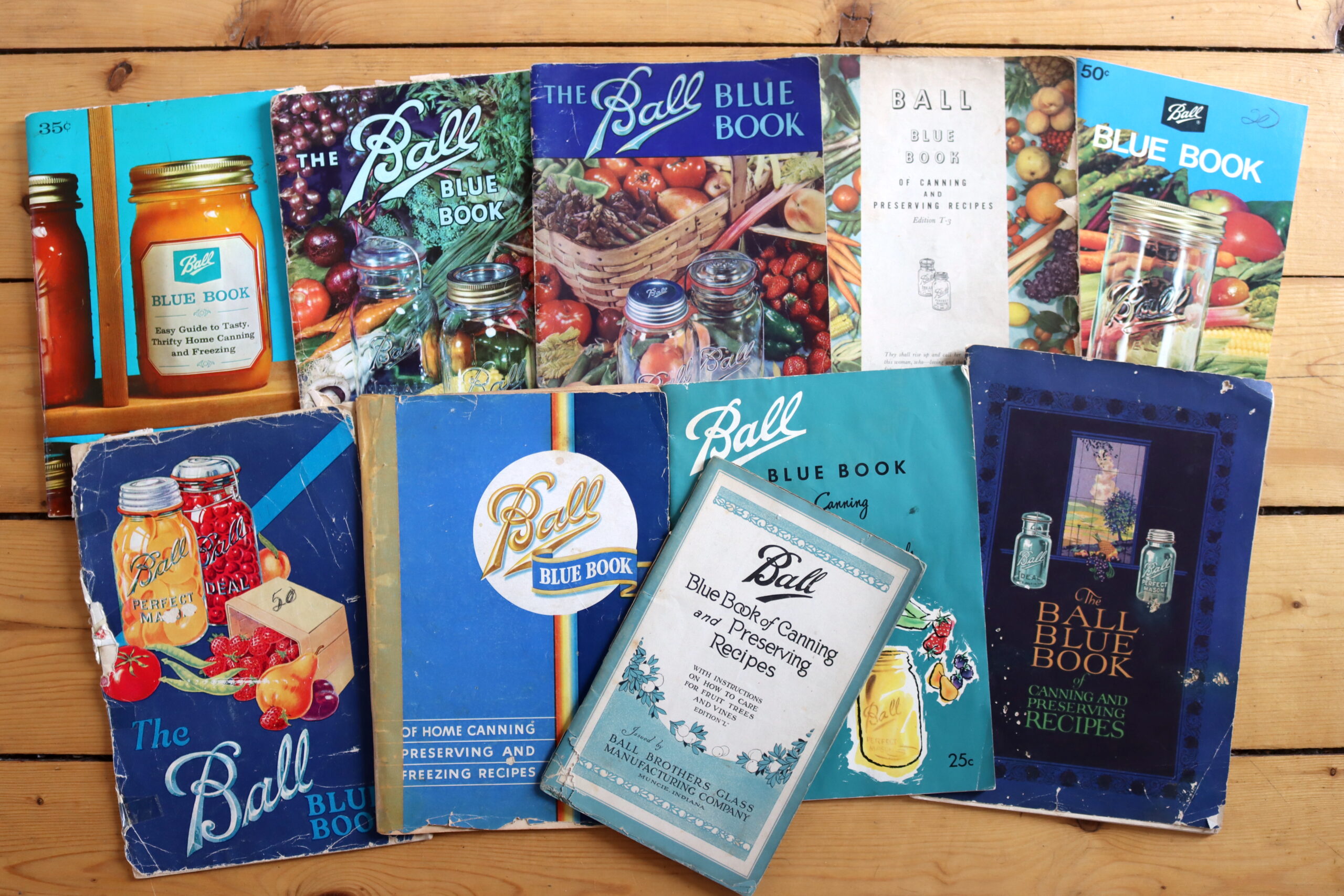
Old Atlas Canning Company Book Editions
At this point, Atlas isn’t as well known as ball canning, but it was just as influential in the early 1900’s. I haven’t been able to find that many of their early works, but I will add them as I come across them.
- It’s All In the Jar: Preserving Recipes Worth Preserving (Circa 1900, Atlas Mason Jars)
Old Kerr Canning Guides
Much like Ball Canning, Kerr also put out recipe books and guides. Most are 40 to 80 pages long, and contain instructions and recipes for canning most garden produce.
Water bath and pressure canning instructions are included.
- The Kerr Home Canning Book and How to Freeze Foods (1936)
- Your Guide to Home Canning from Kerr (1938)
- The Kerr Home Canning Book (1940)
- The Kerr Treasure Chest of Home Canning (1945)
- The Kerr Home Canning Book (1955)
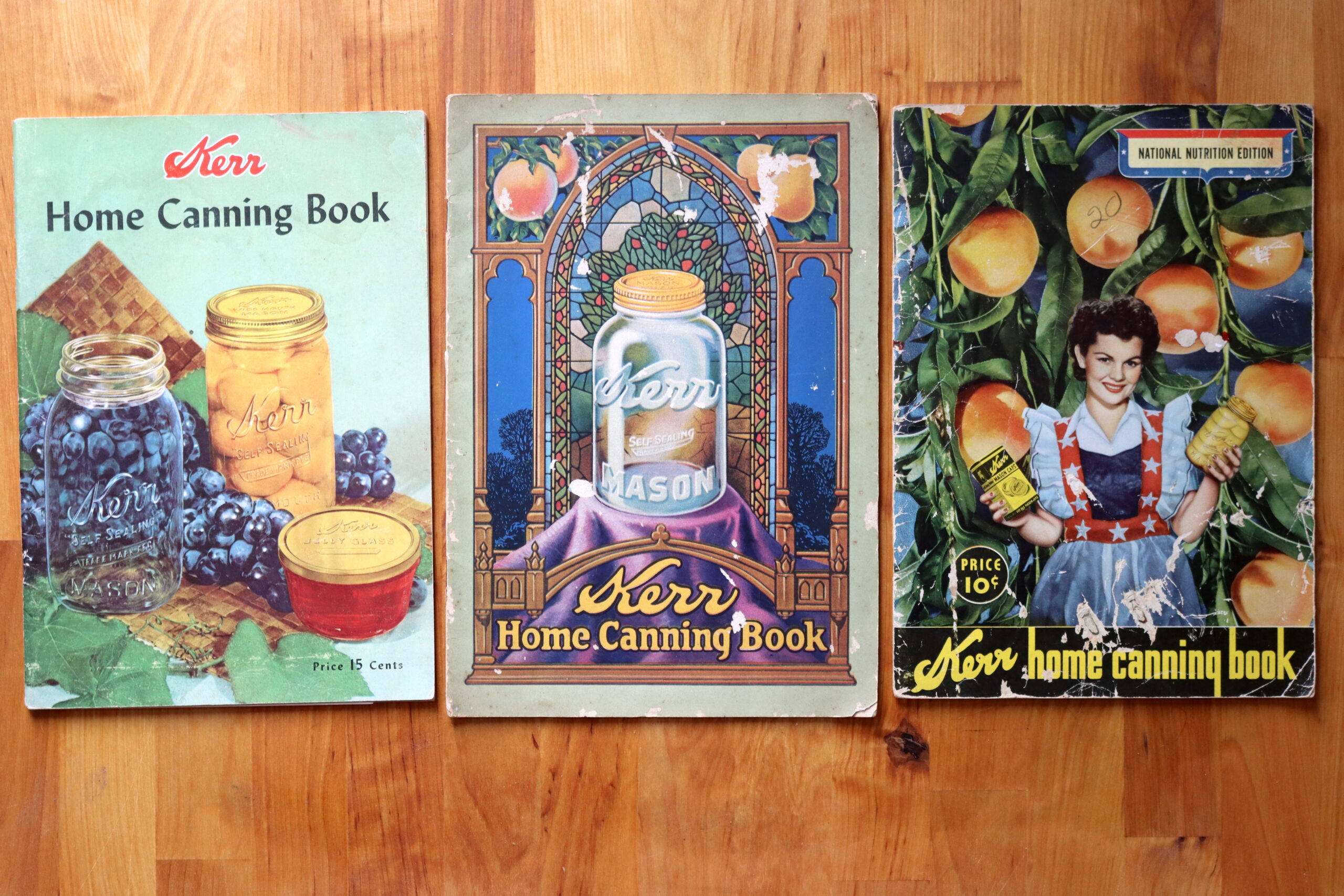
Old Canner Manufacturer Guides
These are the pamphlets and instruction booklets that came with canners when they were first purchased. These days, All American Canner sends out a book that’s nearly 100 pages long, including instructions for pressure canning just about everything. Back when they were first introduced, they included instructions for everything as well.
They also often include ads for vintage canning products that don’t exist anymore, like a massive home tomato canner that’s wood-fired and probably requires its own shed to store it (like a modern maple sugar house, but just a tomato canning house).
- The All-American Way of Canning and Cooking with All-American Pressure Cookers of Molded Aluminum (Undated, but likely 1930 to 1940)
- Everything For Canning From National Canning Supply Co. (Undated, but likely 1910 to 1930)
Old US Department of Agriculture & Extension Service Canning Books and Pamphlets
The US government was especially invested in home canning and preservation during both World Wars. They promoted victory gardens, of course, but they also put out countless pamphlets on how to store and preserve your homegrown produce.
Since the US government produced them, they’re not protected by the same copyright restrictions that would be in place for privately produced publications. They’ve continued to put them out, though less prolifically than during wartime, and there are still free, readily available books and guides from the US government from the 60s, 70s, and 80s. Most of their more recent publications are online only on their website, rather than in specific printed guides.
- Canned Fruit, Preserves, and Jellies: Household Methods of Preservation (1905, US Department of Agriculture, Farmer’s Bulletin 203)
- Canning Vegetables at Home (1909, US Department of Agriculture, Farmer’s Bulletin 359): The first publication put out by the US Department of Agriculture providing instructions for canning food at home. There is also a copy of the publication here.
- Home Canning of Fruits and Vegetables (1910) North Carolina Department of Agriculture
- Canning Business for the Farm Home (1913) Cornell University Extension
- Home Canning (1914) Texas Agriculture Extension Service
- Good Quality and Safe Home Canned Foods (1914) Texas Agricultural Extension Service
- When, what, and how to can and preserve fruits and vegetables in the home (1915) Tuskegee Institute Agriculture Station, Bulletin 26
- Canning, Preserving and Picking (1915) US Department of Agriculture
- Canning Fruits and Vegetables on the Farm (1915) University of Idaho Extension
- Preserves, Pickles and Relishes (1916) West Virginia Agriculture Extension
- Home Canning By the One Period Cold Pack Method (1917 US Department of Agriculture, Farmer’s Bulletin 853): This “cold pack method” is actually modern water bath canning where food is put into jars and then processed in boiling water. Open Kettle canning was called “hot pack” back then and meant just putting food in jars and capping it without putting it into a pot of boiling water. This pamphlet was produced to teach the method to university extension classes in the South.
- Canning and Preserving with 4H Recipes (1917) North Carolina Extension Service
- Principles of Jelly Making (1917) Cornell University Extension
- Home Canning (1917) Connecticut Committee of Food Supply, US Government
- Pickles and Relishes (1917) University of Missouri Extension Service
- Food Saving in Texas: Drying, Brining, Canning and Curing (1917) Texas A&M Extension
- Cold Pack Method for Home Canning (1919) Perdue Extension Bulletin 82
- Jelly Making (1920s) Winthrop College and the US Department of Agriculture
- Home Canning of Fruits and Vegetables (1923, US Department of Agriculture, Farmer’s Bulletin 1211): One of the first publications that acknowledge that “processing” as it was done with boiling originally does not mean sterilization of the contents of the jars, and that pressure canning is necessary for sterilization.
- Preservation of foods: A guide for canning club members (1924) Virginia A&M Extension
- Homemade Fruit Butters (1928) US Government
- Canning for the Home (1932) Virginia A&M Extension
- Jams, Jellies and Preserves (1936) US Department of Agriculture
- Homemade Jams, Jellies and Preserves (1938) US Department of Agriculture
- Home Canning of Fruits and Vegetables (1941, US Department of Agriculture, Farmer’s Bulletin 1762): A later version of the earlier produced bulletin 359 and 1211.
- Cooperative Canning of Fruits and Vegetables (1941, US Department of Agriculture, Cooperative Research and Service Division, Bulletin 47)
- Canning for Victory for Home and Country (1942) University of Georgia Extension
- Canned Food Manual Prepared for the United States Army (1942)
- Wartime Canning of Fruits and Vegetables (1943) US Government
- Canning For The Home (1944) Bulletin 128 Virginia Agricultural College
- Pickle and Relish Recipes (1944) US Government
- Home Canning of Meat (1945) US Government
- Home Canning Processes for Low Acid Foods (1946) US Department of Agriculture Bulletin No. 930
- Home Canning of Fruits and Vegetables (1965) US Department of Agriculture, Home and Garden Bulletin No. 8
- Jellies, Jams, Preserves, Marmalades and Butters (1973) Texas A&M Extension
- Canning, Freezing and Storing Garden Produce (1977) US Department of Agriculture
- Home Canning of Fruits and Vegetables (1983) US Department of Agriculture, Home and Garden Bulletin No. 8
Specific Crop Guides
These aren’t generally canning guides but rather specific crop guides put out by the US government to help growers in specific regions.
They’re deeper dives into specific crops.
- Canning Peaches on the Farm (1910, US Department of Agriculture, Farmer’s Bulletin 426)
- Canning Tomatoes At Home, In Clubs, or For Market (1913, US Department of Agriculture, Farmer’s Bulletin 521)
Canning Book Sources
These sources have even more free online canning books:
- UPenn Online Canning and Preserving Library
- Texas Tech Historical Cookbook Archive
- University of Iowa Digital Library
- The Hathi Trust
- Survivor Library Canning Books
- Archive.org Canning and Preserving
Other Helpful Resources:
- The Early History of USDA Home Canning Recommendations
- USDA National Agriculture Library Timeline of Canning History
- How Did We Can? The Evolution of Home Canning Practices
Old Canning Posters, Ads, Cartoons, and Photographs:
- 1946 Patriotic US “Fighting Famine by Canning At Home” Poster
- Canned Goods in a Root Cellar in the 1940’s
- The Weaker Sex (Cartoon)
- Uncle Sam’s Canning Recipe
- Nearing the End of Canning Season
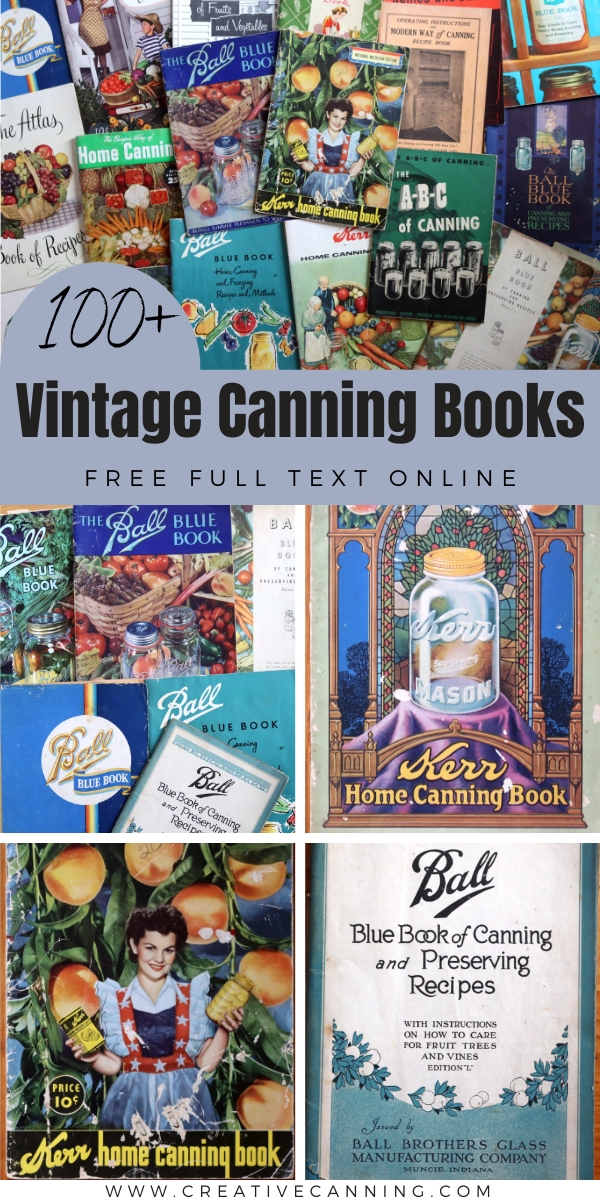
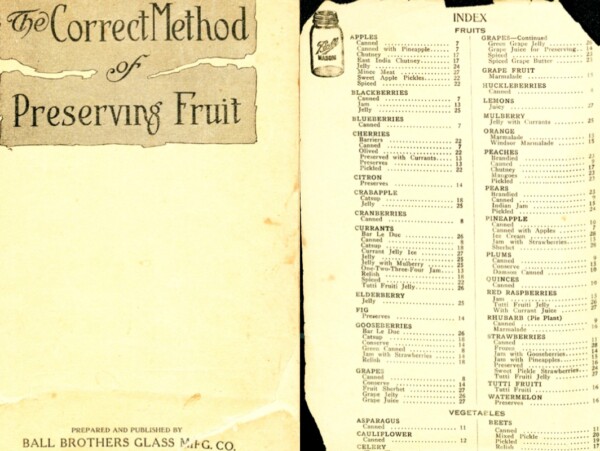
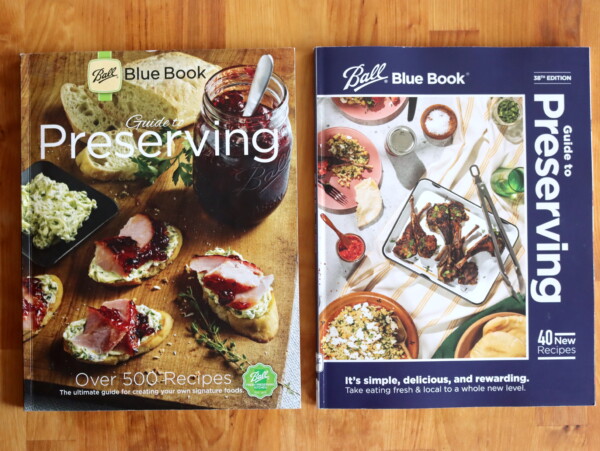

Thank you for the history lesson. Very informative. Makes sense the terminology meanings have changed and people did not realized that time moved on. I had to teach myself to can with books from the library. Pouring wax on top of preserves. No waterbathing. This was pre-1992. I waterbath and pressure can according to directions. I shudder thinking of boiling something for HOURS just to get out of pressure canning.. I love pressure canning.
I have a Ball Blue Book dated 2011 which I did not see in any of your lists.. I hoped to send 2 photos, but I see no way to do that.
Thank you for all you hard, careful work.
Thank you! That’s interesting, I did a bit of googling and it looks like there was a printing in 2011 and I found the cover images. It’s unclear if that is the 35th edition or the 36th edition? Does it say anything about the edition number on the copyright page?